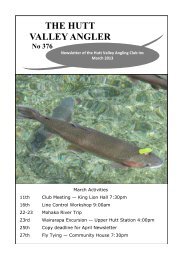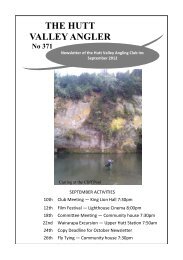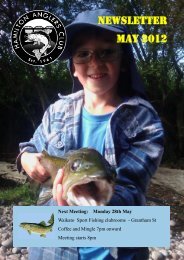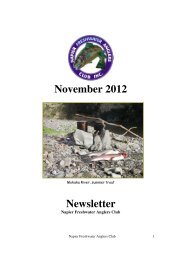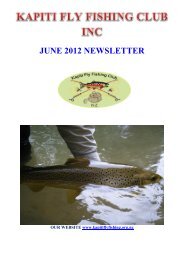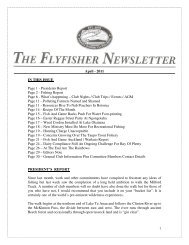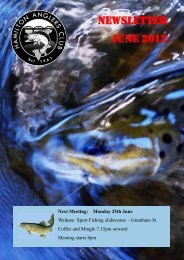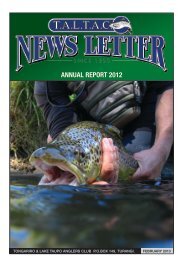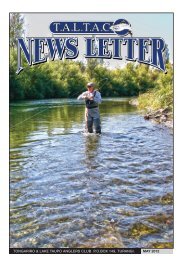May - Christchurch Fishing and Casting Club
May - Christchurch Fishing and Casting Club
May - Christchurch Fishing and Casting Club
Create successful ePaper yourself
Turn your PDF publications into a flip-book with our unique Google optimized e-Paper software.
Both Lakes Arapuni <strong>and</strong> Karapiro continue to produce high catch rates of large fish. The<br />
cool summer <strong>and</strong> high flows have produced excellent growth rates, <strong>and</strong> we are getting a<br />
lot of positive feedback from anglers. It would be at least 10 years since the hydro lakes<br />
fished this well.<br />
The small stream fishing continues to be outst<strong>and</strong>ing, partly because it was such a wet<br />
summer that we are still seeing good flows – despite the recent long period of dry<br />
weather. Streams along the Kaimai Ranges <strong>and</strong> the headwaters of the Waipa are holding<br />
large numbers of trout, including big browns that have recently moved in from the lower<br />
reaches.<br />
Further south, it can be difficult to fish the gorge sections of the Whakapapa <strong>and</strong> upper<br />
Whanganui due to the low angle of the sun shading much of the river <strong>and</strong> making it hard<br />
to spot fish or even to read the water. Over summer we’ve received mixed reports from<br />
both rivers. <strong>Fishing</strong> success appears to vary considerably day-by-day, <strong>and</strong> with the<br />
expertise of the angler.<br />
AT THE END ARE THE RAINBOWS<br />
Hugh Creasy<br />
There’s a fold in the hills, a twist of rock <strong>and</strong> clay where grass grows greener <strong>and</strong><br />
griselina grows untouched by grazing animals. And at the foot of an old hoheria,<br />
bedraggled in the autumn, with half its leaves gone, there is a bog where sedges push<br />
aside the grass <strong>and</strong> a trickle of brown water falls to a narrow valley, a gorge. It is the<br />
beginning of a river – its source.<br />
A few venturesome sheep have left their hoofmarks in the bog, but for the most part the<br />
steepness of the surrounding countryside keeps larger animals at bay. This is the grazing<br />
ground of hares, the habitat of skinks <strong>and</strong> geckos, sunbathing on the boulders. The<br />
mayflies <strong>and</strong> caddis rise from the gorge to rest on the rock faces <strong>and</strong> become sustenance<br />
for predators.<br />
There are soldier flies <strong>and</strong> hairy-headed moth midges where a tangle of fallen tree trunks<br />
has blocked the gorge. The decaying organic matter feeds them for all the years it takes<br />
trees to disintegrate <strong>and</strong> disappear. The water here seeps rather than flows, <strong>and</strong> where the<br />
gorge ends <strong>and</strong> the stream becomes defined there are patches of gorse <strong>and</strong> broom where<br />
mallards have molted <strong>and</strong> left their feathers strewn. In the stream, where the first pool is<br />
shaded, a giant kokopu hovers in the mud, its presence revealed by a waving dorsal fin.<br />
At the foot of the pool, smaller galaxids keep station, each with an invisible territory, a<br />
living space to graze <strong>and</strong> hunt.<br />
Below the pool the corpse of a ewe, dead during lambing in the spring, is now a hollow<br />
shell of bedraggled leather <strong>and</strong> wool, home to dronefly maggots, ready to pupate. The<br />
corpse has been visited by eels <strong>and</strong> all soft tissue has long gone but the carcass has<br />
released a rich diet to the stream’s wildlife.<br />
19




